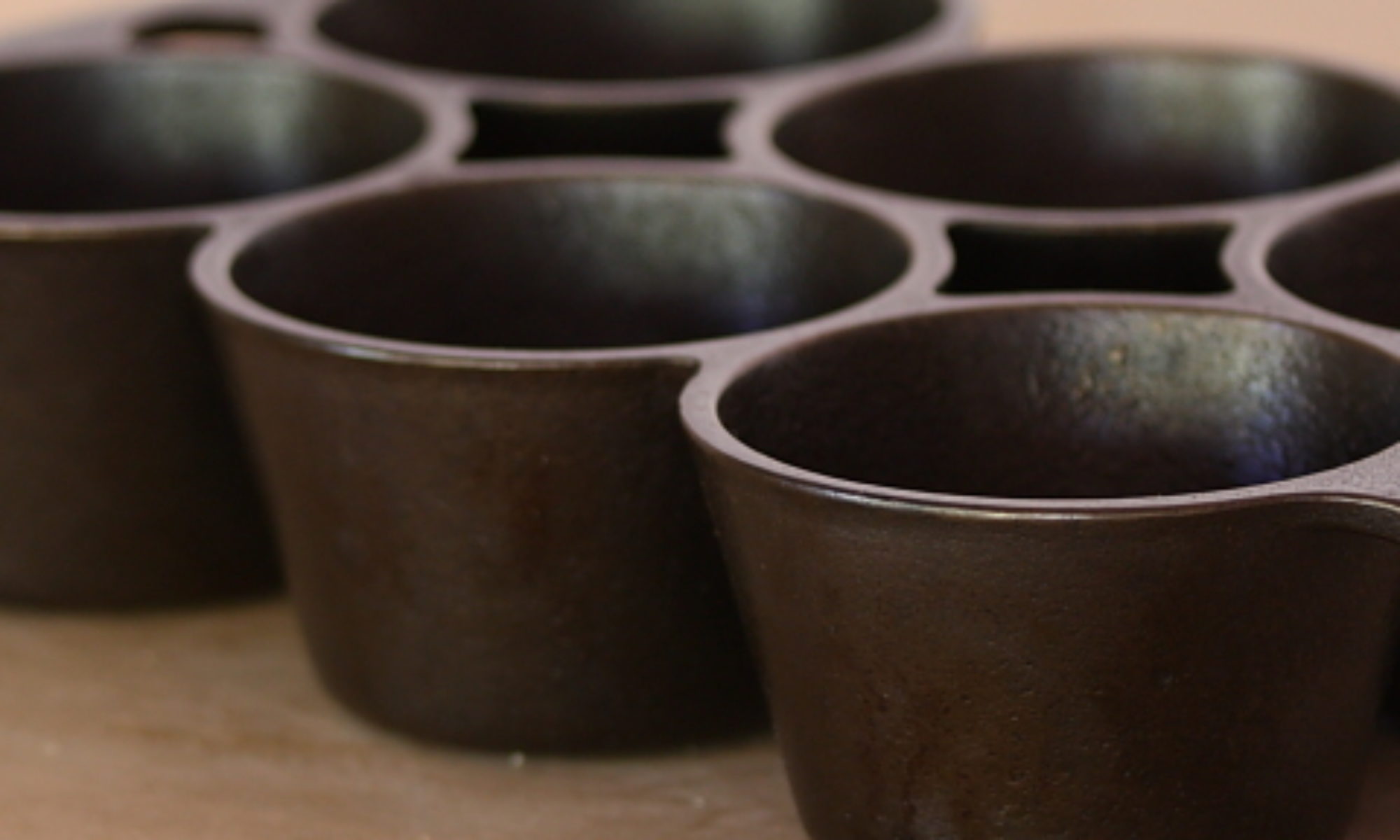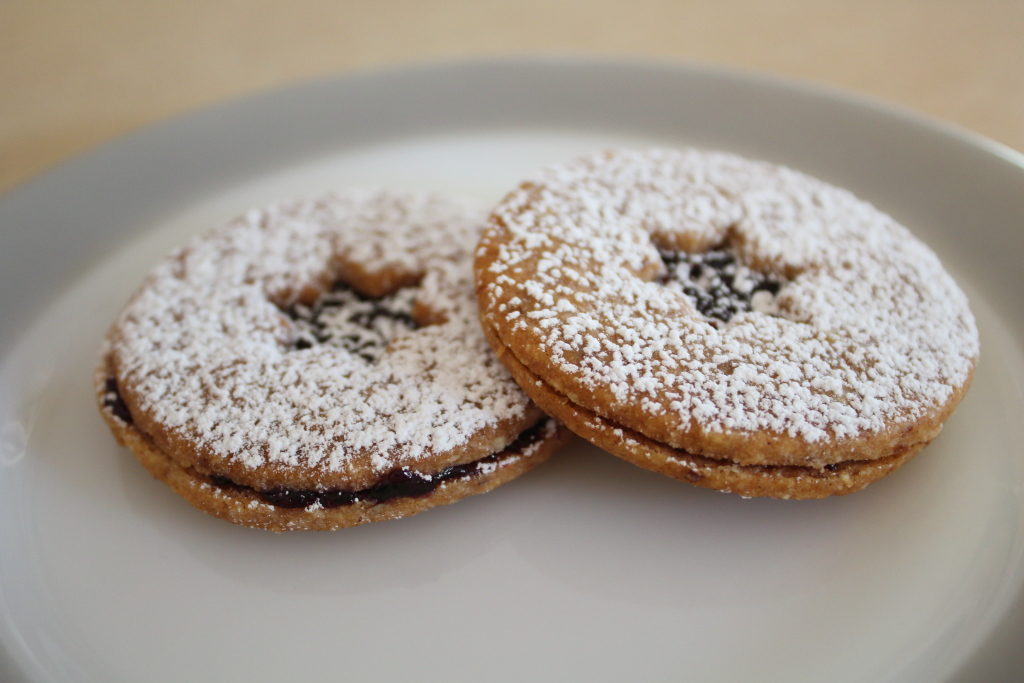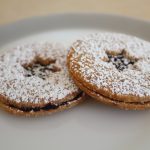
Okay, if you’re going to make these cookies, you need to learn an important mantra: “The freezer is my friend. The freezer is my friend.” Keep that in mind, because you’ll need to repeat it many times. If you do remember it, you’ll be making some really tasty cookies. If not, you’ll pull out all your hair in frustration.
Most people don’t think of a freezer being important for making cookies, or, for that matter, being important for any sort of pastry, but we happen to know that it’s a vital tool in making pastries of all kinds, especially cakes. We even think that we’ve read that professional pastry chefs rate a freezer as second only to a large stand mixer in terms of usefulness; this recipe will show you why.
Also, we didn’t come up with this recipe on our own; we followed the one at the New York Times.
Linzer Cookies
Ingredients
- 435 g all-purpose flour (3 cups)
- 75 g almond meal or almond flour (3/4 cup)
- 1 1/2 tsp ground cinnamon
- 1 tsp baking powder
- 1 tsp kosher salt
- 340 g unsalted butter, room temperature (1 1/2 cups or 3 sticks)
- 250 g sugar (1 1/4 cups)
- 2 eggs
- 1 tsp vanilla
- 1 cup jam raspberry is traditional; we used Cherry Lambic Jam
Instructions
- In a large bowl, whisk together flour, almond meal, cinnamon, baking powder, and salt. Set aside.
- Cream butter in the bowl of a stand mixer fitted with the paddle attachment on medium speed until smooth and glossy, about a minute. Slowly add sugar and beat on medium until fluffy, about 5 minutes.
- Add eggs, one at a time, and beat in completely before adding the next.
- Beat in vanilla extract.
- Add flour mixture and mix until just combined.
- Turn out dough onto a clean work surface and divide into two pieces. Wrap each in plastic and refrigerate overnight.
- Preheat oven to 350°F. Line baking sheets with baking parchment or silicone baking mats.
- Working with about one-fourth of the dough at a time, roll between two sheets of parchment to a thickness of 1/8 inch. Place rolled dough in the freezer for 10 minutes.
- Peel parchment from both sides of the rolled dough to loosen, placing rolled dough back on one of the sheets. Cut 2-1/2 inch circles from dough, and cut 1 inch circles in the center of half the cookies (or use a linzer cookie cutter), immediately transferring the cookies to the prepared pans, leaving an inch of space between them.
- Bake for 18-20 minutes, rotating from top to bottom and back to front, halfway through.
- Allow cookies to cool completely on a baking rack.
- Repeat with remaining dough, re-rolling the scraps into the next piece of dough.
- Once cooled, spread about 1 teaspoon of jam on a solid cookie, and place a cookie with a cutout on top. Repeat with remaining cookies.
- Dust with powdered sugar.
Notes
Ingredient discussion:
We’d made some Cherry Lambic Jam, so we felt as if we should use some of it in these cookies, but raspberry jam is traditional. If you want, be non-traditional and use another flavor of jam. It’ll be fine.
Procedure in detail:
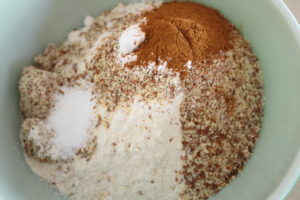
Mix dry ingredients. In a large bowl, whisk together the flour, almond meal, cinnamon, baking powder, and salt. Give all the ingredients a really good stirring, since they won’t be mixed much later, and not many people like getting lumps of baking powder in their cookies.
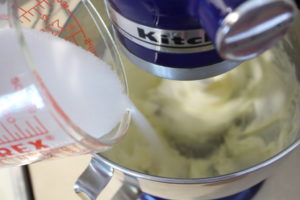
Cream butter and sugar. Place the butter in the bowl of a stand mixer fitted with the paddle attachment and beat on medium. If your butter is warm enough, it should look smooth and shiny rapidly, generally in under 15 seconds. If the butter is a little too cool, it might take as long as a minute. If you have to go longer than a minute, your butter probably needs to warm a bit more before it’ll cream properly, so let it sit in the bowl for 15 to 30 minutes and try again. Once it’s smooth and shiny, slowly add the sugar. We like to add the sugar about as quickly as it gets incorporated into the butter. Once all the sugar is added, beat on medium until the mixture is light and fluffy, about 5 minutes.
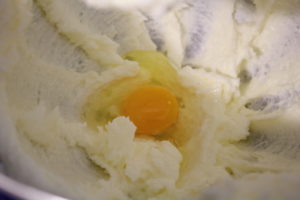
Add eggs. Add the eggs, one by one, beating in thoroughly after each addition. You’ll notice that the mixture will look broken at first, but the eggs will beat in nicely. Give them each about a minute of beating on medium speed.
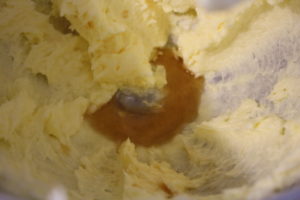
Add vanilla. Add the vanilla and beat in thoroughly. We don’t think you can really beat the mixture too long, but a minute is more than enough.
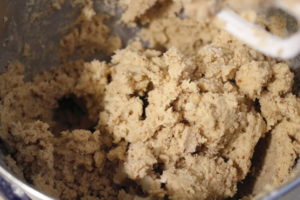
Mix in dry ingredients. Turn off the mixer, add the dry ingredients in one fell swoop, and start mixing. What we like to do is detach the paddle attachment and use it to start incorporating the dry ingredients. That will help eliminate the dreaded poof of flour that spews out of the mixer when it’s first turned on. Once much of the flour mixture is incorporated, reattach the paddle, and mix on low until just combined.
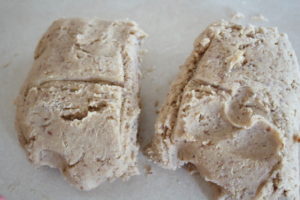
Chill. Turn out the dough onto a clean work surface, and, if needed, give the dough a few quick kneadings to make sure everything is mixed. Divide the dough into two pieces, shape into rounds or rectangles about an inch thick, wrap in plastic, and refrigerate overnight. By now you’ve noticed that the dough is really, really, soft when warm, so maximize the time the dough stays in the fridge.
Preheat oven to 325°F. Line baking sheets with silicone baking mats — that’s what we used — or baking parchment.
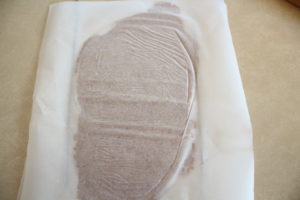
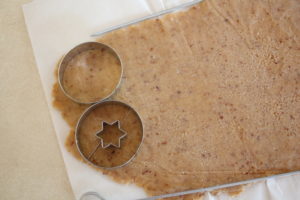
Roll, freeze, cut. Here’s where you learn that a freezer can be your best tool when making pastries. Even after it was chilled overnight, we found this dough to be very soft. So soft that we could only work with about 1/4 of the dough at a time. Cut off a chunk of dough, place it between two pieces of parchment, and roll to a thickness of about 1/8 of an inch. We use two long shish-ke-bob skewers, one placed on each side of the dough, as thickness guides. Once rolled, place on a baking sheet and transfer to the freezer for about 10 minutes. Remove the rolled dough from the freezer and peel away both sides of parchment to loosen, placing the dough back on one sheet. If you have one, use a linzer cookie cutter to cut out plain rounds and rounds with the center cut out. If you don’t have a linzer cookie cutter, you can use a round cutter about 2 1/2 inches in diameter, and another 1 inch in diameter to cut out rounds. Cut out the centers of half the rounds. All the scraps can be re-rolled in the next batch of cookies. And remember the mantra: “the freezer is my friend.”
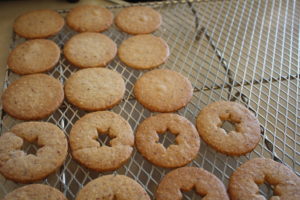
Bake. Transfer the cut cookies to your baking sheet, leaving about an inch of space between each cookie, and bake for 18-20 minutes, or until the cookies are golden brown. Once baked, carefully transfer to a rack to cool completely.
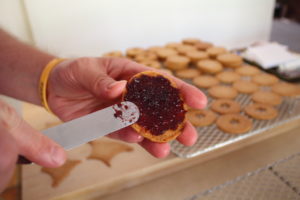
Fill. It’s simple to make sandwich cookies: just spread jam on a whole round cookie, and top with a cookie with a hole in the middle. Continue until you have a bunch of linzer cookies.
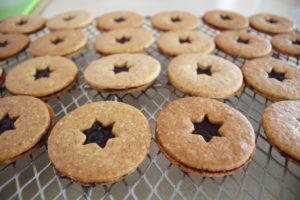
Dust with sugar. We did this outside for easy cleanup. We placed the filled cookies on a baking rack, took them outside, and dusted the cookies with powdered sugar. Once dusted, we transferred the cookies to an airtight tin. For cleanup, we just hosed off the baking rack and set it in the sun to dry.
While we thought these were really good, we were surprised by how well they were received by other people. Several people said it was one of the best cookies they’ve ever eaten, which, after the not-fun of rolling the dough, was quite pleasing to hear. Simply because of that, we’ll give them five stars, but we’ll relegate the making of them to special occasions.
